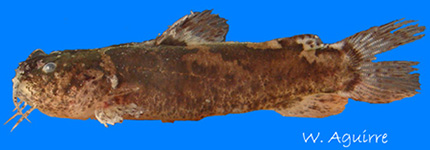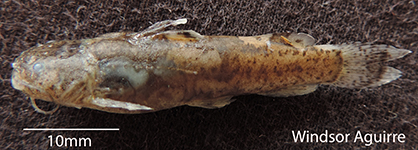| SOURCE FOR OCCURRENCE IN ECUADOR: This species is common in the Guayas River drainage. There are many references for its occurrence in the area (e.g., Eigenmann, 1922; Ovchynnyk, 1971; Glodek, 1978; Ferraris, 2007; Laaz & Torres, 2010). |
| ORIGINAL DESCRIPTION: Eigenmann, C.H., A.W. Henn, & C. Wilson. 1914. New fishes from western Colombia, Ecuador, and Peru. (Contrib. Zool. Lab. Ind. Univ. No. 133.) Indiana University Studies No. 19: 1-15. |
| TYPE SPECIMENS: |
| TAXONOMIC STATUS: Valid (Eschmeyer and Fricke, 2011). |
| RANGE ECUADOR: Guayas River drainage. |
| RANGE OUTSIDE OF ECUADOR: None. |
| COLLECTIONS IN ECUADOR: |
| MAXIMUM SIZE: 6 cm (Glodek, 1978). |
| DISTINGUISHING FEATURES: Microglanis variegatus differs from other species by the following characters: small size (under 60 mm as adults), broad flat head, eye without free orbital margin, premaxillary tooth band without a posterior projecting angle, strong spines present in dorsal and pectoral fins, barbels short, not reaching dorsal fin origin, adipose fin present as a low keel that is much longer than anal-fin base (Glodek, 1978). |
| ECOLOGY: Microglanis variegatus is an endemic species in western Ecuador. Species in this genus are mostly secretive and nocturnal. Microglanis variegatus can inhabit small burrows along stream banks and shallow rocky or riffle areas of small streams (Glodek, 1978). |
| ECONOMIC IMPORTANCE: This species is not of economic importance because of its small size. |
| CONSERVATION STATUS: NA. |
| LINK TO FISHBASE PAGE: Click here for link |
| SPECIES PROFILE CREATED BY: Enrique Laaz |
| SPECIES PROFILE CONTRIBUTORS: Windsor Aguirre |

